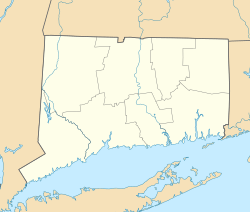Rossie Velvet Mill Historic District facts for kids
Quick facts for kids |
|
|
Rossie Velvet Mill Historic District
|
|
| Location | Roughly along Bruggerman Court, Bruggerman Place, Greenmanville Avenue, Hinckly Street, Pleasant Street, Rossie Street, Velvet Street, Stonington, Connecticut |
|---|---|
| Area | 120 acres (49 ha) |
| Architect | Favretti, Giovanni; et al. |
| Architectural style | Colonial Revival, Bungalow/Craftsman |
| NRHP reference No. | 07000110 |
| Added to NRHP | March 9, 2007 |
The Rossie Velvet Mill Historic District is a special area in Mystic, a village within Stonington, Connecticut. It's known for the old Rossie Velvet Mill, a big brick building that used to make velvet fabric. Today, this building is a research center for the nearby Mystic Seaport Museum. The district also includes many homes built for the mill workers between the 1850s and 1950s. This historic area covers about 120 acres (49 ha) and was added to the National Register of Historic Places on March 9, 2007.
Contents
What is the Rossie Velvet Mill District?
The Rossie Velvet Mill Historic District is a neighborhood in Mystic, Connecticut. It stretches along Greenmanville Avenue, from Pleasant Street in the north down to the Mystic Seaport Museum. The most important building is the former Rossie Velvet Mill itself. This large brick factory once made beautiful velvet cloth.
Homes for Mill Workers
Most of the buildings in the district are houses. These homes were built to provide places for the people who worked at the velvet mill to live. They were constructed over a long period, from around 1850 to 1950. This shows how the area grew and changed as the mill operated.
History of the Rossie Velvet Mill
Before the mill was built, this area was mostly farmland. Farmers grew food and other goods for the people working in the shipbuilding industry and other businesses in Mystic. This changed when a small textile mill started operating nearby in 1850.
How the Velvet Mill Began
The Rossie Velvet Mill officially opened in 1897. Two main reasons led to its creation. First, a local business group wanted to bring velvet makers from Germany to the area. They had already had success doing this in another part of Stonington. Second, a new law called the McKinley Tariff was passed in 1890. A "tariff" is like a tax on goods brought into a country. This tariff made it more expensive to import velvet from other countries.
German Velvet Makers Come to America
Because of the McKinley Tariff, the owners of a velvet mill in Süchteln, Germany, decided to move their factory to the United States. This way, they could avoid the new tax. They chose Mystic, Connecticut, as their new home. This was a huge success for the town.
A Major Local Employer
The Rossie Velvet Mill became the biggest employer in Mystic village. It hired about 200 workers. Many of these workers were skilled German immigrants who already knew how to weave velvet. Their experience helped the mill produce high-quality fabric.
The Mill's Later Years
The Rossie Velvet Mill faced tough times during the Great Depression. This was a period in the 1930s when many businesses struggled, and lots of people lost their jobs. The Rossie operation failed, but the factory soon reopened under new owners. However, the mill eventually closed for good in 1958. Today, the old mill building is used as a research center for the Mystic Seaport Museum, keeping its history alive.



